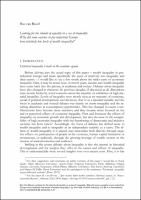Chapter Looking for the islands of equality in a sea of inequality. Why did some societies in pre-industrial Europe have relatively low levels of wealth inequality?
| dc.contributor.author | Van Bavel, Bas | |
| dc.date.accessioned | 2022-06-01T12:11:49Z | |
| dc.date.available | 2022-06-01T12:11:49Z | |
| dc.date.issued | 2020 | |
| dc.identifier | ONIX_20220601_9788855180535_219 | |
| dc.identifier.uri | https://library.oapen.org/handle/20.500.12657/56036 | |
| dc.description.abstract | This paper scrutinizes the insights won by recent studies in wealth inequality in pre-industrial Europe. It focuses on the regions and periods where levels of inequality were relatively low, trying to arrive at an inventory of causes of these exceptions. It discusses catastrophic events, colonization and revolution as possible causes, but argues that these only occasionally had a leveling effect, depending on the social and institutional context in which they occurred. Most clearly wealth accumulation was restricted, even by maximums on ownership, where associative organizations held a solid position, and market and state played lesser roles as coordination systems. | |
| dc.language | English | |
| dc.relation.ispartofseries | Datini Studies in Economic History | |
| dc.subject.other | Economic inequality | |
| dc.subject.other | economic history | |
| dc.subject.other | European economic history | |
| dc.subject.other | pre-industrial age | |
| dc.title | Chapter Looking for the islands of equality in a sea of inequality. Why did some societies in pre-industrial Europe have relatively low levels of wealth inequality? | |
| dc.type | chapter | |
| oapen.identifier.doi | 10.36253/978-88-5518-053-5.27 | |
| oapen.relation.isPublishedBy | bf65d21a-78e5-4ba2-983a-dbfa90962870 | |
| oapen.relation.isbn | 9788855180535 | |
| oapen.series.number | 1 | |
| oapen.pages | 26 | |
| oapen.place.publication | Florence |

